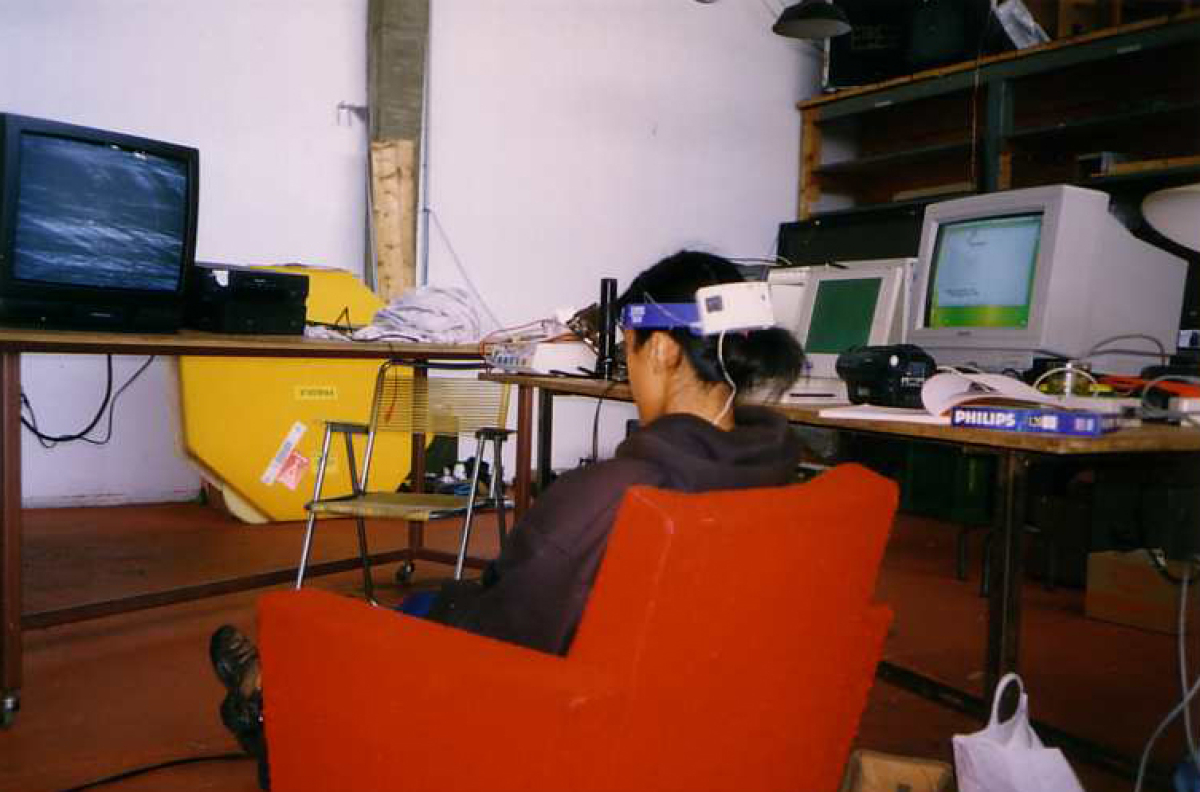Place:
Linz, AT;
Site:
Time's Up Laboratories
Date:
-
"Does visual entertainment have an effect on the physical body?"

Report 8/26
Hypothesis:
Flicker rates found in TV static can induce physical and emotional responses ranging from meditative to high tension, even epileptic seizures.
Set-up:
*Test subject-New Zealand male
*Flicker/static sampled from Madrid TV as stimulus
*IBVA system to measure and monitor brainwave emissions
*MAX interface to track frequency levels of brain waves
Experiment:
Test subject observes static/flicker. All responses are recorded.
Results:
1)Slight tightening of chest, waves of anxiety/excitement across chest in sync with horizontal and vertical movement of lines across screen.
2)Increased frequency of low beta waves over time
3)Internal distraction occurs at fairly regular intervals
Conclusions:
Responses occurred, though slight, to stimulus.
Feedback loop needed to limit internal distraction.
For Test 2.1
Translate brainwaves emitted while watching TV static into sound.
Create feedback loop with sound to intensify response.
FOUND DATA
* Television flickers. The lines that make up the picture are refreshed 25 times per second and the whole screen flashes 50 times per second. Both sources of flicker can cause seizures.
-Wilkins, Darby, Stefanson, Jeavons and Harding. Television epilepsy: the role of pattern. Electroencephalography and clinical Neurophysiology.
* Flicker is not perceptible at frequencies of about 100 flashes per second, but it nevertheless affects firing of cells in the retina and subcortical structures.
-Berman, Greenhouse, Bailey, Clear, and Raasch. Human electroretinogram responses to video displays, fluorescent lighting and other high frequency sources.
* Heart rate is increased when fluorescent lighting flickers impercetibly.
-Watts and Wilkins. The role of provocative visual stimuli in agoraphobia.
Psychological Medicine.
Report 8/28
FOCUS:
"Does visual entertainment have an effect on the physical body?"
GOAL:
Brainwave spectrum emitted while watching flicker translated into sound.
SET UP
test subject: asian-american female
IBVA
Madrid flicker video sample
MAX interface
SuperCollider to emulate sounds using algorithmic functions
Test A
emulation of spectrum detected by volume level changes in pink noise
Result:
-slight building of pressure in head
-very slight nausea
-changes in noise level in sync with horizontal lines moving across the screen
Test B
set pitch to follow the dominant frequency of spectrum
Result:
-pitch changes with frequency of eye movements
-little change in sound
Test C
set beat to follow dominant frequency without eye movement. set ground frequency to constant of 200 hz. Beat frequency 200 - 460 hz.
Note
*change in test subject to australian male*
-subject fell asleep
-little to no brainwave activity
-little change in sound
Conclusion:
Changes in frequency levels too slight to create dynamic sound range.
Increase in activity of observer may create sufficient levels for more interesting sounds results.
Hypothesis:
Flicker rates found in TV static can induce physical and emotional responses ranging from meditative to high tension, even epileptic seizures.
Set-up:
*Test subject-New Zealand male
*Flicker/static sampled from Madrid TV as stimulus
*IBVA system to measure and monitor brainwave emissions
*MAX interface to track frequency levels of brain waves
Experiment:
Test subject observes static/flicker. All responses are recorded.
Results:
1)Slight tightening of chest, waves of anxiety/excitement across chest in sync with horizontal and vertical movement of lines across screen.
2)Increased frequency of low beta waves over time
3)Internal distraction occurs at fairly regular intervals
Conclusions:
Responses occurred, though slight, to stimulus.
Feedback loop needed to limit internal distraction.
For Test 2.1
Translate brainwaves emitted while watching TV static into sound.
Create feedback loop with sound to intensify response.
FOUND DATA
* Television flickers. The lines that make up the picture are refreshed 25 times per second and the whole screen flashes 50 times per second. Both sources of flicker can cause seizures.
-Wilkins, Darby, Stefanson, Jeavons and Harding. Television epilepsy: the role of pattern. Electroencephalography and clinical Neurophysiology.
* Flicker is not perceptible at frequencies of about 100 flashes per second, but it nevertheless affects firing of cells in the retina and subcortical structures.
-Berman, Greenhouse, Bailey, Clear, and Raasch. Human electroretinogram responses to video displays, fluorescent lighting and other high frequency sources.
* Heart rate is increased when fluorescent lighting flickers impercetibly.
-Watts and Wilkins. The role of provocative visual stimuli in agoraphobia.
Psychological Medicine.
Report 8/28
FOCUS:
"Does visual entertainment have an effect on the physical body?"
GOAL:
Brainwave spectrum emitted while watching flicker translated into sound.
SET UP
test subject: asian-american female
IBVA
Madrid flicker video sample
MAX interface
SuperCollider to emulate sounds using algorithmic functions
Test A
emulation of spectrum detected by volume level changes in pink noise
Result:
-slight building of pressure in head
-very slight nausea
-changes in noise level in sync with horizontal lines moving across the screen
Test B
set pitch to follow the dominant frequency of spectrum
Result:
-pitch changes with frequency of eye movements
-little change in sound
Test C
set beat to follow dominant frequency without eye movement. set ground frequency to constant of 200 hz. Beat frequency 200 - 460 hz.
Note
*change in test subject to australian male*
-subject fell asleep
-little to no brainwave activity
-little change in sound
Conclusion:
Changes in frequency levels too slight to create dynamic sound range.
Increase in activity of observer may create sufficient levels for more interesting sounds results.
References:
Related publications: